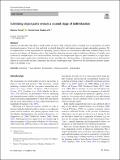Subitizing object parts reveals a second stage of individuation
Date
17/11/2020Metadata
Show full item recordAbstract
Humans can efficiently individuate a small number of objects. This subitizing ability is thought to be a consequence of limited attentional resources. However, how and what is selected during the individuation process remain outstanding questions. We investigated these in four experiments by examining if parts of objects are enumerated as efficiently as distinct objects in the presence and absence of distractor objects. We found that distractor presence reduced subitizing efficiency. Crucially, parts connected to multiple objects were enumerated less efficiently than independent objects or parts connected to a single object. These results argue against direct individuation of parts and show that objecthood plays a fundamental role in individuation. Objects are selected first and their components are selected in subsequent steps. This reveals that individuation operates sequentially over multiple levels.
Citation
Poncet , M & Chakravarthi , R 2020 , ' Subitizing object parts reveals a second stage of individuation ' , Psychonomic Bulletin & Review , vol. First Online . https://doi.org/10.3758/s13423-020-01836-2
Publication
Psychonomic Bulletin & Review
Status
Peer reviewed
ISSN
1069-9384Type
Journal article
Collections
Items in the St Andrews Research Repository are protected by copyright, with all rights reserved, unless otherwise indicated.

